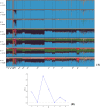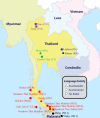Forensic and genetic characterizations of diverse southern Thai populations based on 15 autosomal STRs
- PMID: 35027632
- PMCID: PMC8758738
- DOI: 10.1038/s41598-021-04646-1
Forensic and genetic characterizations of diverse southern Thai populations based on 15 autosomal STRs
Abstract
Southern Thailand is home to various populations; the Moklen, Moken and Urak Lawoi' sea nomads and Maniq negrito are the minority, while the southern Thai groups (Buddhist and Muslim) are the majority. Although previous studies have generated forensic STR dataset for major groups, such data of the southern Thai minority have not been included; here we generated a regional forensic database of southern Thailand. We newly genotyped common 15 autosomal STRs in 184 unrelated southern Thais, including all minorities and majorities. When combined with previously published data of major southern Thais, this provides a total of 334 southern Thai samples. The forensic parameter results show appropriate values for personal identification and paternity testing; the probability of excluding paternity is 0.99999622, and the combined discrimination power is 0.999999999999999. Probably driven by genetic drift and/or isolation with small census size, we found genetic distinction of the Maniq and sea nomads from the major groups, which were closer to the Malay and central Thais than the other Thai groups. The allelic frequency results can strength the regional forensic database in southern Thailand and also provide useful information for anthropological perspective.
© 2022. The Author(s).
Conflict of interest statement
The authors declare no competing interests.
Figures





References
-
- Eberhard, D.M., Simons, G.F. & Fennig, C.D. Ethnologue: languages of the World. 23rd eds. (SIL International, 2020).
-
- Premsrirat S. Language map of ethnic groups in Thailand. J. Lang. Cult. 2002;21:5–35.
-
- Higham C, Thosarat R. Early Thailand from prehistory to Sukhothai. River Books; 2012.
Publication types
MeSH terms
Grants and funding
LinkOut - more resources
Full Text Sources

